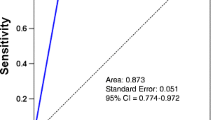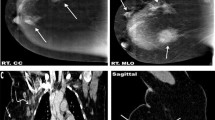Abstract
Dual-energy contrast-enhanced mammography is one of the latest developments in breast care. Imaging with contrast agents in breast cancer was already known from previous magnetic resonance imaging and computed tomography studies. However, high costs, limited availability—or high radiation dose—led to the development of contrast-enhanced spectral mammography (CESM). We reviewed the current literature, present our experience, discuss the advantages and drawbacks of CESM and look at the future of this innovative technique.







Similar content being viewed by others
References
Lewin J (2001) Dual-energy contrast protocol offers new tool to detect breast cancer. Diagn Imaging 11:107–112
Dromain C, Thibault F, Muller S et al (2011) Dual-energy contrast-enhanced digital mammography: initial clinical results. Eur Radiol 21(3):565–574
Jong RA, Yaffe MJ, Skarpathiotakis M et al (2003) Contrast-enhanced digital mammography: initial clinical experience. Radiology 228:842–850
Allec N, Abbaszadeh S, Scott CC et al (2012) Including the effect of motion artifacts in noise and performance analysis of dual-energy contrast-enhanced mammography. Phys Med Biol 57(24):8405–8425
Lewin JM, Isaacs PK, Vance V et al (2003) Dual-energy contrast-enhanced digital subtraction mammography: feasibility. Radiology 229(1):261–268
Jochelson MS, Dershaw DD, Sung JS et al (2013) Bilateral contrast-enhanced dual-energy digital mammography: feasibility and comparison with conventional digital mammography and MR imaging in women with known breast carcinoma. Radiology 266(3):743–751
Chakraborty DP, Barnes GT (1989) An energy sensitive cassette for dual-energy mammography. Med Phys 16(1):7–13
Dromain C, Balleyguier C, Adler G et al (2009) Contrast-enhanced digital mammography. Eur J Radiol 69(1):34–42
Bornefalk H, Lewin JM, Danielsson M et al (2006) Single-shot dual-energy subtraction mammography with electronic spectrum splitting: feasibility. Eur J Radiol 60(2):275–278
Diekmann F, Diekmann S, Taupitz M et al (2003) Use of iodine-based contrast media in digital full-field mammography—initial experience. Rofo 175(3):342–345
Skarpathiotakis M, Yaffe MJ, Bloomquist AK et al (2002) Development of contrast digital mammography. Med Phys 29(10):2419–2426
Dromain C, Balleyguier C, Muller S et al (2006) Evaluation of tumor angiogenesis of breast carcinoma using contrast-enhanced digital mammography. AJR 187(5):W528–W537
Lobbes MB, Smidt ML, Houwers J et al (2013) Contrast-enhanced mammography: techniques, current results, and potential indications. Clin Radiol 68(9):935–944
Diekmann F, Freyer M, Diekmann S et al (2011) Evaluation of contrast-enhanced digital mammography. Eur J Radiol 78(1):112–121
Diekmann F, Diekmann S, Jeunehomme F et al (2005) Digital mammography using iodine-based contrast media: initial clinical experience with dynamic contrast medium enhancement. Invest Radiol 40(7):397–404
Badr S, Laurent N, Régis C et al (2014) Dual-energy contrast-enhanced digital mammography in routine clinical practice in 2013. Diagn Interv Imaging 95:245–258
Fallenberg EM, Dromain C, Diekmann F et al (2014) Contrast-enhanced spectral mammography versus MRI: initial results in the detection of breast cancer and assessment of tumour size. Eur Radiol 24(1):256–264
Fallenberg EM, Dromain C, Diekmann F et al (2014) Contrast-enhanced spectral mammography: does mammography provide additional clinical benefits or can some radiation exposure be avoided? Breast Cancer Res Treat 146(2):371–381
Dromain C, Thibault F, Diekmann F et al (2012) Dual-energy contrast-enhanced digital mammography: initial clinical results of a multireader, multicase study. Breast Cancer Res 14(3):R94
Mokhtar O, Mahmoud S (2014) Can contrast enhanced mammography solve the problem of dense breast lesions? Egypt J Radiol Nucl Med. doi:10.1016/j.ejrnm.2014.04.007
Cheung YC, Lin YC, Wan YL et al (2014) Diagnostic performance of dual-energy contrast-enhanced subtracted mammography in dense breasts compared to mammography alone: interobserver blind-reading analysis. Eur Radiol. doi:10.1007/s00330-014-3271-1
Thibault F, Balleyguier C, Tardivon A et al (2012) Contrast enhanced spectral mammography: better than MRI? Eur J Radiol 81(Suppl 1):S162–S164
Francescone MA, Jochelson MS, Dershaw DD et al (2014) Low energy mammogram obtained in contrast-enhanced digital mammography (CEDM) is comparable to routine full-field digital mammography (FFDM). Eur J Radiol 83(8):1350–1355
Lobbes MB, Lalji U, Houwers J et al (2014) Contrast-enhanced spectral mammography in patients referred from the breast cancer screening programme. Eur Radiol 24(7):1668–1676
Froeling V, Diekmann F, Renz DM et al (2013) Correlation of contrast agent kinetics between iodinated contrast-enhanced spectral tomosynthesis and gadolinium-enhanced MRI of breast lesions. Eur Radiol 23(6):1528–1536
Drukker K, Duewer F, Giger ML et al (2014) Mammographic quantitative image analysis and biologic image composition for breast lesion characterization and classification. Med Phys 41(3):031915
Tsai CJ, Chen RC, Hung SH et al (2012) Feasibility study for the improvement of microcalcification visualization in different breast thicknesses and tissue components using a dual-energy approach in digital mammography. J Comput Assist Tomogr 36(4):488–494
Conflict of interest
None.
Author information
Authors and Affiliations
Corresponding author
Rights and permissions
About this article
Cite this article
Daniaux, M., De Zordo, T., Santner, W. et al. Dual-energy contrast-enhanced spectral mammography (CESM). Arch Gynecol Obstet 292, 739–747 (2015). https://doi.org/10.1007/s00404-015-3693-2
Received:
Accepted:
Published:
Issue Date:
DOI: https://doi.org/10.1007/s00404-015-3693-2




